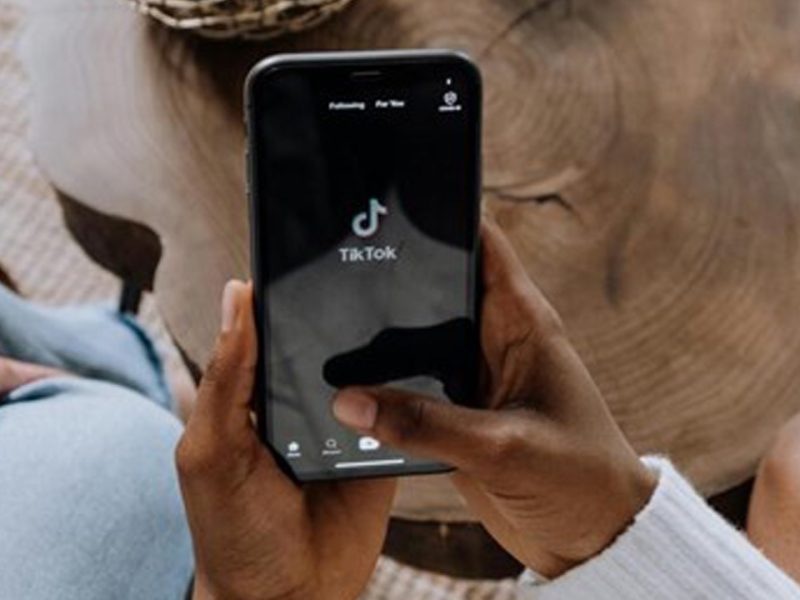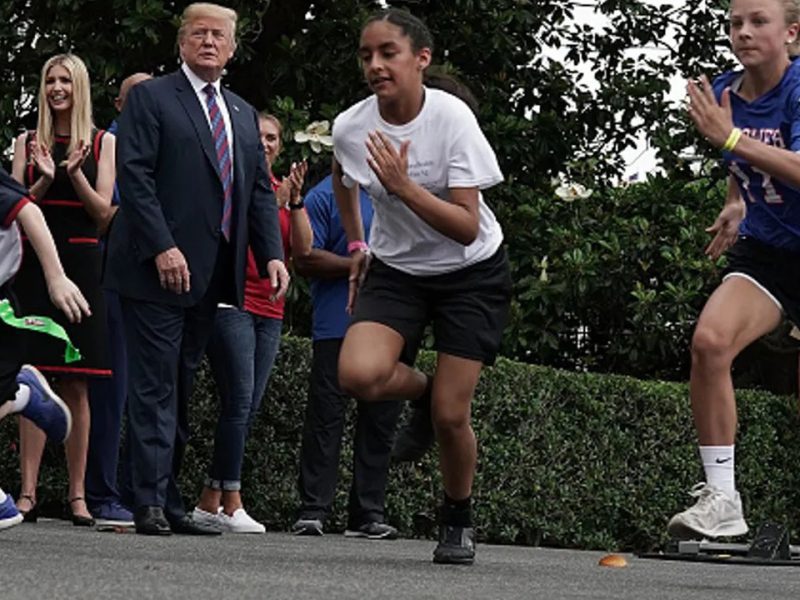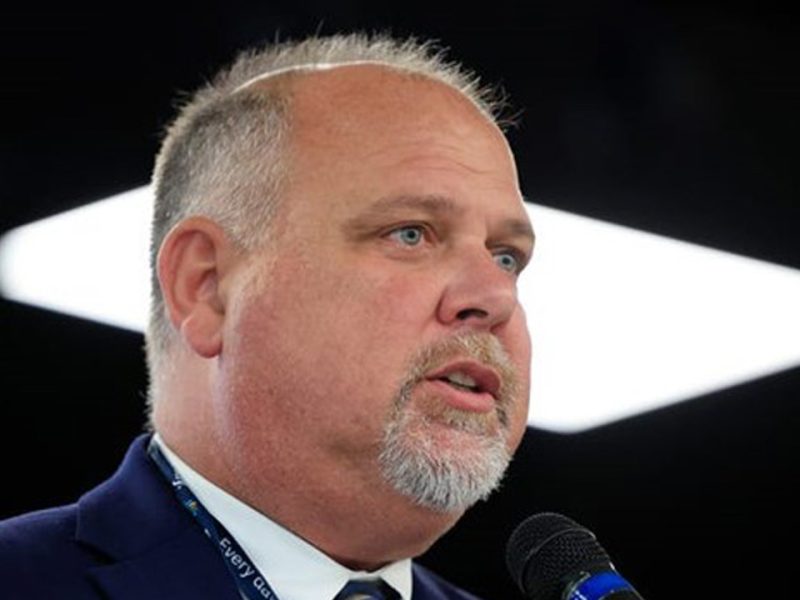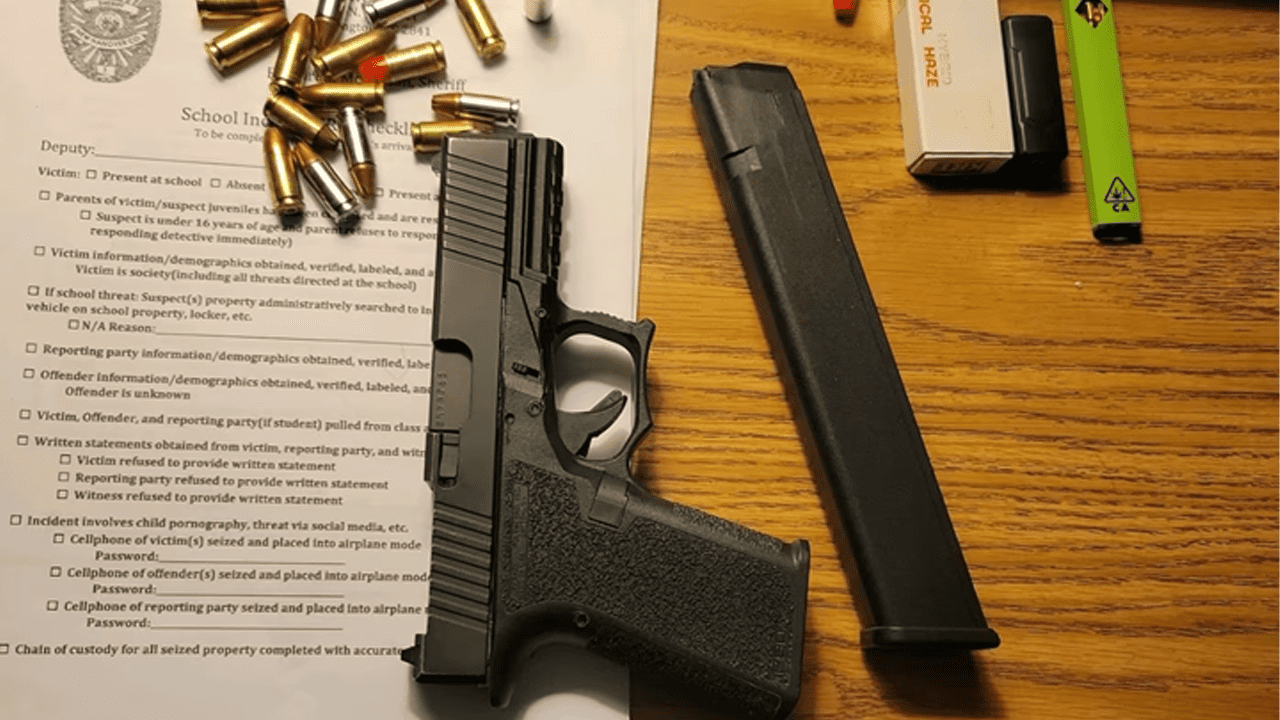
Guns are seized in U.S. schools each day. The numbers are soaring.
The Washington Post | By Robert Klemko, John Woodrow Cox, Lizzie Johnson and Steven Rich | October 10, 2023
Jaden Wood didn’t know about the gun brought to school on the fourth day of his junior year until he got home and the news spread on social media. An assistant principal at Rome High in northwest Georgia had gotten a tip and confronted a ninth-grader, police would later say. But the 15-year-old refused to give up his backpack, prompting a resource officer to wrestle him to the floor. Inside the bag, a staff member found a black 9mm handgun loaded with seven rounds, including one in the chamber.
Jaden, then 16, felt more annoyed than frightened. He was, at last, an upperclassman, with his own parking spot and aspirations for the year ahead: AP classes, starting on the soccer team and, maybe, finding a girlfriend. The gun was an aberration.
“It’s not going to happen again,” he remembered thinking on that Wednesday evening in early August 2022.
And then it did — on the fifth day of school.
A 16-year-old was spotted on a security camera with a Glock sticking out of his jacket pocket, police said. It, too, was loaded. Rome High, Jaden understood, would not soon get past this, and neither would he.
“School a war zone …” the teen wrote on Instagram.
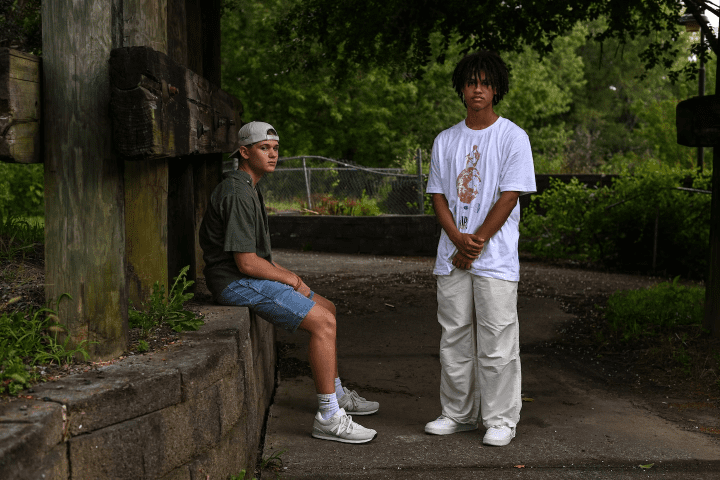
Rome High School seniors Jaden Wood, left, and Markevis Watkins, shown in August, were attending class last year when two students brought guns to school on back-to-back days. (Joshua Lott/The Washington Post)
In the United States, where gun violence has soared since the pandemic began, Jaden’s experience is one shared by students of every age in every state throughout the school year —a bleak reflection of a society awash in firearms.
Last school year, news reports identified more than 1,150 guns brought to K-12 campuses but seized before anyone fired them, according to an investigation by The Washington Post. That’s more than six guns each day, on average. Nationwide, 1 in 47 school-age children — 1.1 million students — attended a school where at least one gun was found and reported on by the media in the 2022-2023 school year.
But the true number is almost certainly far higher. A Washington Post survey of 51 of the country’s largest school systems showed that 58 percent of seizures in those districts last academic year were never publicly reported by news organizations. Those same districts said the number of guns recovered on campus rose sharply in recent years, mirroring the growing prevalence of firearms in many other public places.
The guns were discovered practically everywhere — bookbags, lockers, trash cans, bathrooms, cars, pockets, purses, bulging behind waistbands and hidden above bathroom ceiling tiles. Some were brought by accident, others to show off. In many cases, police alleged, they were brought to end lives.
A Florida 16-year-old was caught after taking selfies with a pink-handled pistol in a high school restroom. In Georgia, a teacher found a handgun inside a diaper bag, and in Illinois, a 10-year-old girlsmuggled in a gun that belonged to her mother, a corrections officer.
At an Ohio high school, a mass shooting plot was foiled, police said, after a student found a lone bullet in a restroom and reported it. In New Mexico, a 26-year-old posing as a Sheriff’s deputy confidently strolled the halls of his former high school with a pistol on his hip; and in Indiana, a man brought a gun to campus because he wanted to prove that schools were not safe. At a Michigan high school graduation, after a fight broke out in the parking lot, police found a .40-caliber gun modified to fire like a machine gun hidden inside a 19-year-old’s pant leg. Each case resulted in criminal charges.
School resource officers often play an essential role in learning who has a gun and seizing it, according to cases reviewed by The Post and interviews with experts. While often seen as a controversial presence on campus, such officers can be crucial in gaining the trust of students and staff, school-safety experts say, and in taking swift action tostop school shootings before they happen.
Anonymous tip apps and systems can also be instrumental; one system that debuted in 2018 has averted at least 15 planned school shootings since then, according to the organization that runs the system. But clear backpacks and metal detectors at school entrances, while reassuring to parents, do little to stop students from slipping guns through side and rear doors. Overall, experts say, expensive weapons-detection technology is no substitute for a school community where children trust adults enough to tell them when something appears to be wrong.
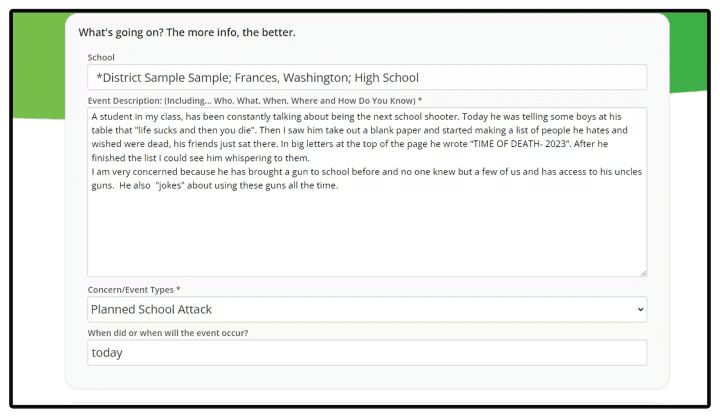
A tip submitted to the Say Something Anonymous Reporting System, launched in 2018 as a tool for students, staff and parents to advise authorities of school safety concerns. The system’s creators say it has helped avert at least 143 acts of violence with a weapon since 2018. (Provided by Sandy Hook Promise)
Some schools and districts openly communicate with parents and staff about weapons seized on campus, creating a dialogue that can teach more parents to lock up their guns at home and lead to more anonymous tips. Many other schools and districts, however, hoping to avoid public scrutiny or raise alarm, have tried to limit who gets information when guns are seized.
In Prattville, Ala., a mother learned from her son that he had a gun pointed at his face at school, while the principal told parents no students were in imminent danger during the incident.Police in Golden Valley, Minn., complained in March that middle school officials waited five days to notify them of two boys who appeared to be posing for social media pictures while holding a gun in the school bathroom; a spokesperson for the Robbinsdale Area Public Schools district said officials have worked since then to improve the school-police partnership.
In each case, the guns inspired uncertainty, anger and fear.
At Rome High,administrators declined to be interviewed but shared a list of security improvements made since the two incidents.
Jaden saiddozens of the school’s 2,000 students were too afraid to go back to campus after the second weapon was found. Two teenagers he knew switched to virtual learning for the rest of the semester.
His best friend, Markevis Watkins, lives in a neighborhood afflicted with gun violence. He’s heard shots at night and lost a cousin in a shooting a few years earlier. School had always felt like a refuge. Now, in just 24 hours, that sense of security had been stripped away.
“I could actually get, like, shot,” Markevis said, remembering how his thinking changed. “I’ve got to be wary of who to be around at school — and whether they’ve got a gun or not.”
A nationwide epidemic
Even an exhaustive review of local news sources cannot account for guns carried into schools undetected, gun seizures never disclosed by districts and guns found on campuses located in communities underserved by news organizations. Still, The Post’s survey recorded guns recoveredat schools in rural, suburban and urban areas, in all 50 states and Washington, D.C.
And those reports tell just part of the story.
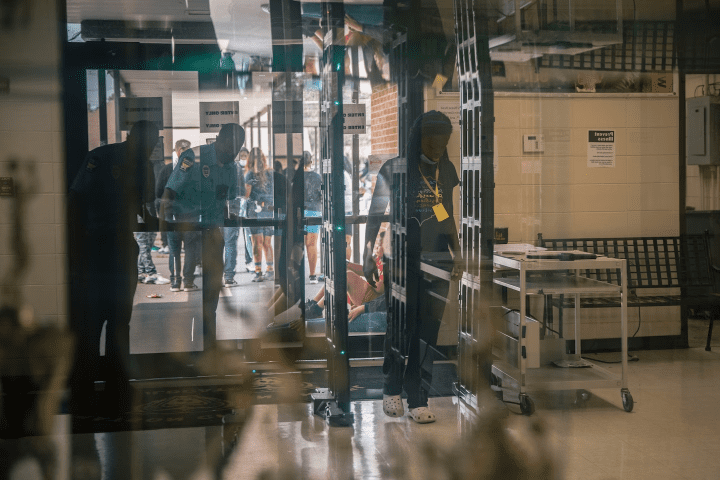
An entrance at Watson Chapel Junior High in Pine Bluff, Ark., in 2021 includes a school resource officer and a metal detector. (Andrea Morales for The Washington Post)
Some local news outlets are stretched too thin to learn about gun seizures in schools, especially if administrators aim to keep incidents quiet, experts said. Other communities experience so much violence that the confiscation of an unfired weapon from a school building filled with children doesn’t rate as news.
“In many ways, these scares at schools are no longer newsworthy,” said Nick Mathews, an assistant professor in the School of Journalism at the University of Missouri who studies American media deserts. “And that’s rather terrifying.”
The Post found that the number of campus gun seizures spiked significantly between the 2018-2019 school year and the 2022-2023 school year — a five-year period that, following the pandemic shutdowns, alsohas seen significantly more behavioral problems in school. The 47 districts for which The Post was able to obtain five full school years of data saw a 79 percent increase in guns found on campuses over that time frame. In many communities, the number of guns found has more than doubled, a trend that mirrors a precipitous rise in school shootings.
In the last full school year before the pandemic, the Arlington Independent School District in Texas found one gun on its campuses. Last school year, that number ballooned to 19. In the Gwinnett County School District in Georgia, the number of guns found jumped from four to 17 over the same period. And in Omaha Public Schools, the tally went from 1 in the 2018-2019 school year to 11 last school year.
Guns found on school campuses have surged since 2018
Across 47 of the largest U.S. public school districts, the number of gun seizures on campus plummeted during pandemic closures, only to spike well above previous levels after schools reopened.
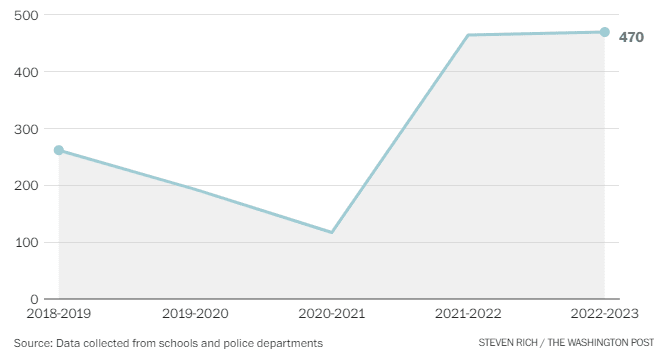
“Kids are more likely to carry firearms, and even to bring firearms into school, if they have been victims of violence themselves, if they aren’t connected to a community, if they have post-traumatic stress,” said Megan Ranney, a leading firearm-injury researcher and dean of the Yale School of Public Health. “We’ve got a lot of kids who are scared … maybe have lost parents from covid, maybe have lost community connections because of shutdowns of community groups during covid. And then add on to it increased access to firearms. A lot of guns bought over the last couple of years. It becomes a perfect storm.”
Though many students brought firearms that they found unlocked in their own homes, The Post’s findings also illustrate the sprawling nature of the illegal gun trade in the United States.
The gun brought to Rome High on the fourth day of school was stolen in Alabama. According to media reports, a gun stolen in Las Vegas found its way into the hands of a 16-year-old at a Lawrence, Mass., high school; another 16-year-old brought a gun stolen in Georgia to his Manchester, Conn., high school; in Columbus, Ohio, a high-schooler showed up with a gun stolen in Martin County, Fla.; and in Nashville, a 17-year-old came to school with two loaded pistols in his backpack, one of them stolen out of Madison, Ala.
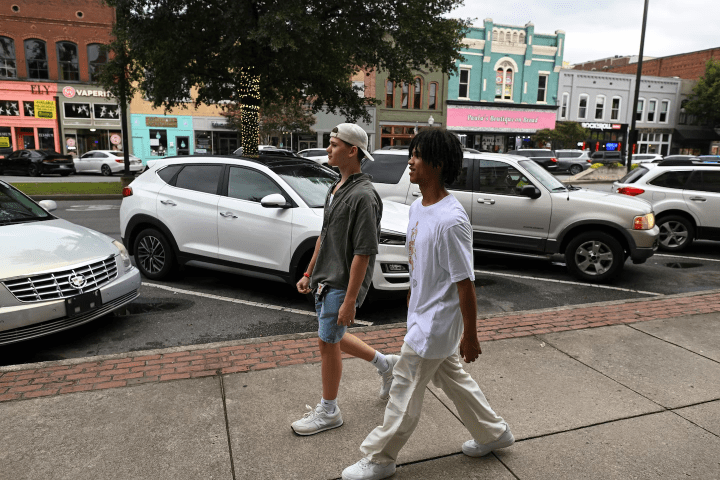
An 18-year-old was arrested at a high school in Ames, Iowa., for possession of a 9mm semiautomatic pistol that was stolen from the center console of a pickup truck in Cape Girardeau, Mo., according to a police report. The teen said he bought the gun from a stranger at a gas station in Missouri, seeking protection, the report said.
Federal law prohibits guns on K-12 campuses, with exceptions for licensed carriers. Last school year, charges against minors found with firearms on campuses varied widely, according to the news reports reviewed by The Post: Some faced only school-issued suspensions, while other were charged with felonies. About 15 percent of gun seizures reported in local media involved adults who were not students at the school. Nearly all of those adults faced state-level charges related to carrying firearms in prohibited areas.
The vast majority of campus gun seizures reported by news organizations involved high-schoolers — the median age was 16, according to The Post’s survey. But authorities found guns on at least 31 students age 10 or younger during the 2022-2023 academic year, the news stories said. As is the case in most school shootings, the majority of those guns were brought to campus by children who could not legally purchase a firearm on their own.
Five in six gun seizures reported in the news involved weapons brought by students
A review of news stories showed guns brought to schools by children as young as 4 and adults as old as 63 during the 2022-2023 school year

In Corpus Christi, Tex., a gun was confiscated near the start of last school year at Los Encinos Elementary, where Lori Garcia’s daughter was in kindergarten. Garcia missed an initial email from the school, which said a student was “allegedly in possession of a dangerous weapon in a backpack.”She first heard about the gun two days later from a news blog.Furious and afraid, she later called her daughter’s teacher, who assured Garcia that the student hadn’t been in her class.
The day after hearing the news about Los Encinos, Garcia was driving when she got another message, this time from Moody High, which her two older children attended. Not one but two students, Garcia learned, had brought guns to the campus.
Panicked, she pulled over and called her husband.
“How are we supposed to send our kids to school every day not knowing if they’re safe?” she recalled asking him.
He asked what choice they had. “They have to go to school.”
At the end of the month, Garcia saw a news story on Facebook. A child had taken a gun to another elementary school in the district, only a mile from the high school.
The student’s father owned the weapon and faced charges for his alleged negligence. The gun, Garcia read, was loaded. The child who had brought it to school was 4 years old.
‘Direct danger’
The automated phone message to parents and guardians from the principal at Prattville Junior High in Alabama was vague but reassuring.
On Feb. 2, a student brought a weapon to the school, then-Principal Janett Skinner said, according to a copy of the recording shared with The Post. She didn’t elaborate on the type of weapon, instead saying that neither students nor staff were ever in “direct danger” and the student with the weapon had been apprehended.
But Jeremy and Katie Mahnke knew better. Their son, an eighth-grader, had told them after school that he knew the student with the weapon, a semiautomatic pistol. The boy was showing off the gun to students in the field house and pointed it at their faces, said the Mahnkes’ son, whom The Post agreed not to name to protect his privacy.
After their son shoved the boy’s arm away, the Mahnkes said, the boy backed off, warned his peers against telling anyone about the gun and left. The couple said an adult at the school later told them he had confiscated the weapon soon after the field-house confrontation.
When Katie picked her son up after school, the first words out of his mouth were: “Momma, I could’ve died today.”
So when they heard Skinner’s recorded message, questions raced through Katie and Jeremy Mahnke’s minds: Was the principal lying, or did she not know the truth? How many other times had there been a gun at school, later described as a “weapon,” with no additional details?
Jeremy typed out an email to Skinner: “Just heard your message. I was told it was pointed at my son’s face. Your message said nobody was in danger. Do I have the facts straight?”
Skinner, who is now an administrator at another school in the district, referred requests for comment to the Autauga County school system. Schools spokesperson Rebecca Thomas said Skinner sent the initial mass communication to parents before receiving witness statements — and had been instructed to do so by the school district’s previous administration.
Ken Trump, a school safety expert who travels the country advising schools and staffs, said he often encounters “old school” principals who are overconfident in their ability to control the message in a crisis.
“They will put out a letter that’s very ambiguous. They won’t use the word ‘gun,’” Trump said. “And all that does is create more ambiguity, because parents are going, ‘Okay, what type of weapon? Was it an AK-47? Was it an explosive device?’ ”
In some cases, administrators leave both parents and staff in the dark.
School officials in San Jose came under heavy criticism in the spring when loaded guns were seized from students in a middle school and a high school a few weeks apart. In between, a student at a different school, Lincoln High, was arrested after allegedly texting others with plansto bring an assault rifle to school and shoot classmates.
In each case, the school system either didn’t notify parents and teachers fast enough or gave them incomplete information, said Elizabeth Neely, an English teacher at Lincoln High who is active in the teachers union.
She had spent time in class with the student accused of making threats after school officials became aware of the situation, and before the student was arrested. Even as other students circulated the threats on social media, the school did not impose a lockdown or put other safety measures in place, Neely said.
The San Jose Unified School District and Lincoln High School did not respond to requests for comment.San Jose Police confirmed the arrest but declined to share details because the student was a juvenile.
Over the next several weeks, Neely helped organize a group of teachers and parents demanding more communication and better training in the event of a shooting threat.
She said they have received mixed messages. When teachers asked for professional tools to barricade classrooms last fall, administrators said the San Jose Police Department advised them not to barricade doors because that could make it hard for officers to get into classrooms.
Yet in August, when teachers had a training session with the police department, they were told to barricade their doors the best they could in an active-shooter scenario — officers would find a way in, Neely recalled police saying. The San Jose Police Department and the San Jose Unified School District did not respond to multiple requests for comment about the training guidance.
Last winter, a student group got their hands on several hundred feet of old firefighter hose that Neely and her fellow teachers could use to bind their classroom doors shut in an emergency. “We felt lied to,” Neely said. “We basically decided we’re going to do whatever we need to do to be safe.”
Teachers in dozens of communities raised similar concerns about school safety after gun incidents last schoolyear. In Harper Woods, Mich., in June, the teachers union accused school officials of trying to cover up an incident in which a student with a gun escaped the school staff and evaded metal detectors; in April, the Massachusetts Teachers Association accused a superintendent of “total disregard for the safety of students and school personnel” after a student posted videos of himself on social media that showed him wielding a gun on campus. The Southbridge, Mass., school system disputed the union’s account and said it was working with police on lockdown drills and other safety procedures.
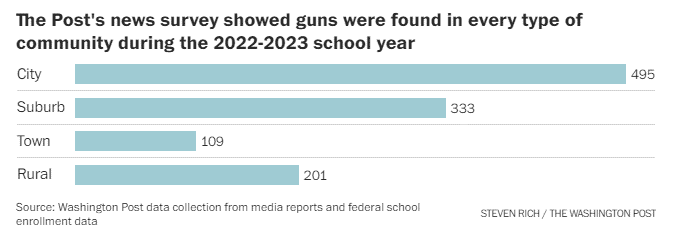
In Prattville last winter, Jeremy Mahnke got a call back from Skinner, the school principal, after sending his email. Skinner assured him the staff would speak to witnesses and get the full story.
But Mahnke’s son had already given a witness statement to administrators before leaving the school in a daze. School officials never updated their initial assessment of the incident publicly, the Mahnkes said. No administrator or counselor checked on their son.
“Just to have that person go up to him and just acknowledge him and have small talk,” Katie Mahnke said. “They never did that.”
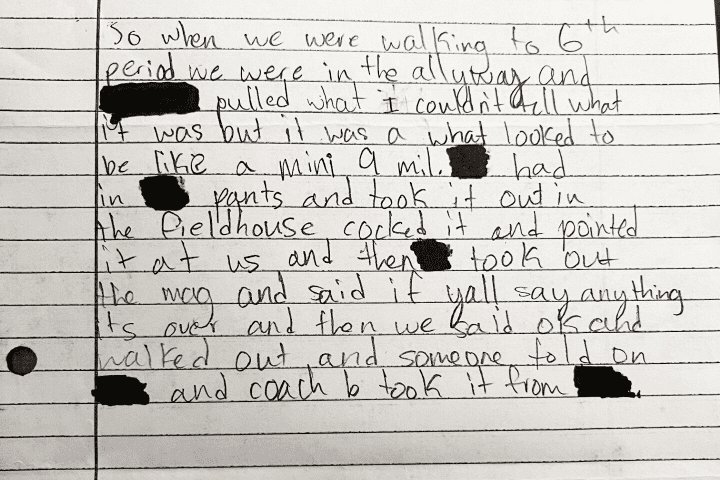
Thomas, the schools spokesperson, offered a different version of events,saying Skinner followed up with parents of affected students to share what happened and offer counseling resources.
Autauga Schools superintendent Lyman Woodfin, who took the position in July, said he’s taken steps to improve security, transparency and communications with parents, and hopes no parent has cause to raise the complaints shared by the Mahnke family in the future.
After the gun seizure, the Mahnkes’ son began watching YouTube videos about the 1999 Columbine High mass killing. He said he wanted to transfer to a private school.
As the family explored that option, Katie felt the need to go public with what had happened. At a March school board meeting, she questioned Skinner’s description of events, asked why she wasn’t notified before her son was interviewed and called for the school to develop a better security plan.
But by then, concern among parents and staff had died down.
“People are just accustomed to it now — guns,” Jeremy said. “There was a gun and yeah, it was taken care of and nobody got hurt. If somebody got shot, that’s a different story.”
Catching it on the front end
As the number of guns seized in Gwinnett County, Ga., schools spiked in recent years, senior officials resolved to bolster security and push for a culture change.
The 180,000-student system, the largest in Georgia, had been in talks with Centegix, a security system that allows staff to wear a badge that is integrated with camera surveillance and can be pressed to alert security staff of an emergency. And the county had considered supplementing an anonymous tip phone hotline with an anonymous tip smartphone application.
As of this school year, both measures are in place. Gwinnett schools also added more counselors and 21 more school resource officers over the summer, bringing the total number of officers in its 142 schools to 113.
Top school officials are encouraging students to speak up about security threats and celebrating those whose tips lead to enforcement action — without naming the student, which could bring backlash.
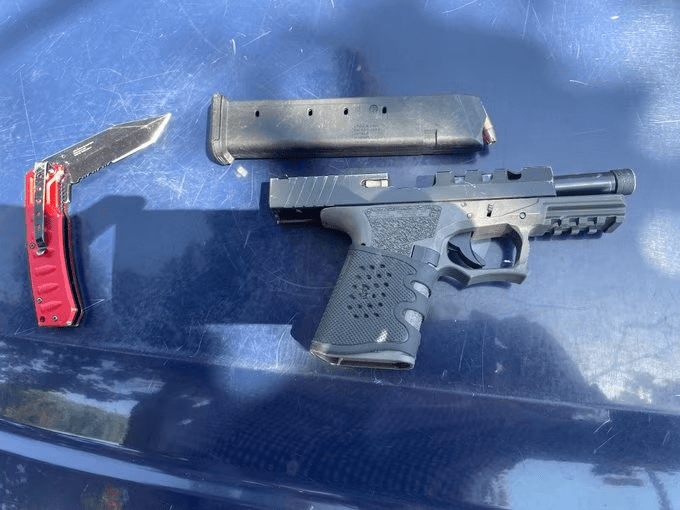
A handgun with a loaded magazine and a knife that were confiscated from a student at Willow Glen High School in California on May 17. (San Jose Police Department)
“While any weapon found in our schools is not a positive thing, we expect — and we’re communicating with our families — that we will see more weapons found in our schools because we’re building this culture that it’s okay to report it,” said Bernard Watson, the school system’s director of media and community relations. “We would much rather catch it on the front end than have to investigate after something bad happens.”
The value of student reporting is something Trump, the school safety expert, stresses when training school leaders. “The number one way you find out about a weapon or a plot is from a kid who comes forward and tells an adult they trust,” he said.
Increasingly, though, schools are turning to surveillance, metal detectors and artificial-intelligence-driven technology rather than dedicating hours of professional training to teaching staff how to foster those relationships, experts said.
No matter how advanced, a weapons detection system is only as effective as a school’s adherence to sound security protocols, experts said. In Cleveland last October, a high school student bypassed metal detectors by entering a back door with a disassembled AR-15-style rifle in his backpack. A district spokesperson said the entrance was subsequently closed to all students.Other schools have reported students being let into buildings by their friends at unmonitored entrances or hiding weapons outside and retrieving them during gym class or other outdoor activities.

One of dozens of cameras around the campus of Vernal Middle School in Utah this year. The cameras have facial and license plate recognition software. (Kim Raff for The Washington Post)
“The school community demands you do something, do anything, do it better and do it now,” Trump said of the reliance on weapons-detection technology. “It solves a political and community relations problem as much, if not more, than a school safety problem.”
Schools that embrace a holistic approach to school safety rely on people in concert with technology. Moms Demand Action, an organization fighting for stricter gun laws in the United States, partners with schools to educate parents and guardians on proper gun storage. In June 2022, Roanoke City Public Schools in Virginia was among a handful of districts nationwide to distribute free gun locks to parents.
In Washington and Chicago, school officials say they’ve had success with low-tech safe-passage programs, in which unarmed adult safety monitors stand along popular routes to school to bear witness and discourage violence as children walk by.
Demographics in schools where the news reported gun seizures
Similar numbers of White, Black and Hispanic students attended the schools where gun confiscations were reported in the news
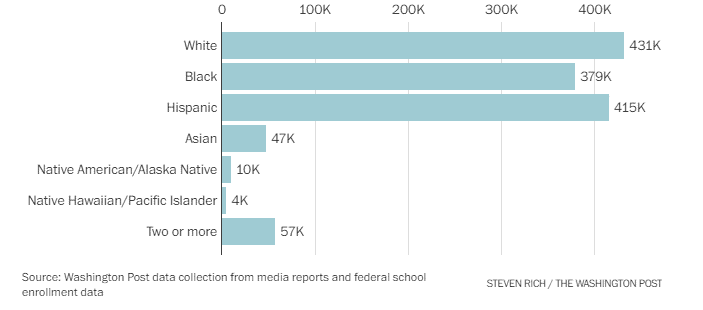
Chicago’s program has expanded from 35 schools in 2009 to 182 today, said Jadine Chou, Chicago Public Schools chief of safety and security. There and in Washington, researchers found many students who brought weapons on campus did so in hopes ofprotecting themselves during their commute to and from school.
“If a child is experiencing stress or trauma or something happens over the weekend when they weren’t even thinking about school, we know that carries with the child when they come to school,” Chou said. “So we have to think about safety 24/7.”
Sandy Hook Promise — a nonprofit launched in the aftermath of the 2012 mass killing at Sandy Hook Elementary School in Connecticut — debuted the Say Something Anonymous Reporting System in 2018. It allows users to anonymously alert school officials of safety concerns at any time of day, online or by phone.
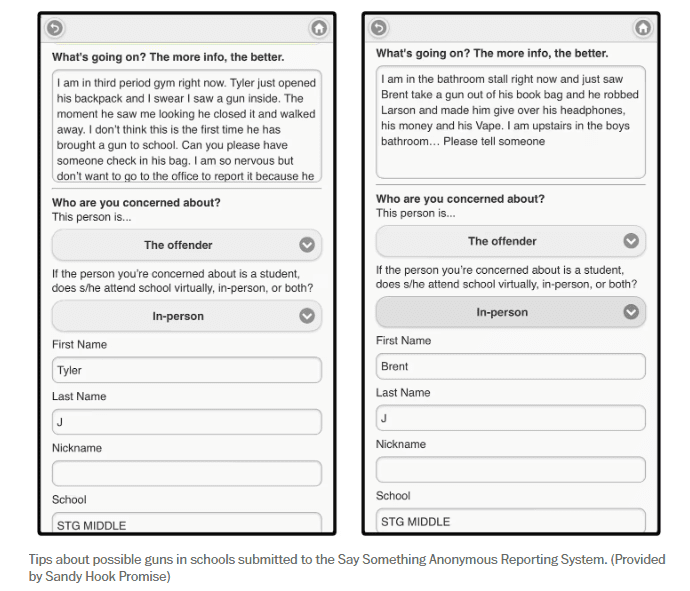
More than 5,000 schools use the program, up from about 4,000 last school year, said Aimee Thunberg, a spokesperson for Sandy Hook Promise. The system is free to schools — Sandy Hook Promise funds it with grass-roots fundraising, corporate philanthropy and federal funds through the Stop School Violence Act of 2018. Its success, Thunberg said, depends on school leaders’ willingness to promote it to their communities.
In the districts they’ve trained, about 3 percent of students and staff, on average, continue to submit tips, Thunberg said, although some school systems see higher participation rates, up to 5 percent. Most tips concern suicidal behavior and drug use.
But the system has averted at least 143 acts of violence with a weapon, including at least 15 planned school shootings, since 2018, Thunberg said. Last fall, a Say Something tip led to the apprehension of two students trying to enter a Durham, N.C., high school with handguns on the same morning.
‘Are the kids going to be okay?’
When preventive measures fail, school security officers and resource officers often represent the final defense against would-be shooters.
The Post found that those officers — while highly unlikely to stop a school shooting in progress — have proved important in seizing guns brought onto school campuses,preventingpotential violence every day.
At Vernal Middle in Utah last fall, Orion Young, a 24-year-old school resource officer, was talking with the secretary when a boy walked into the school’s front office with disturbing news.
He had seen a loaded gun in his 13-year-old classmate’s backpack. He’d heard the youth planned to shoot his ex-girlfriend and her best friend. He had brought the girls with him to the office, just in case.
Young — the school’s first full-time school resource officer, who had grown up in Vernal and been on the jobonly a few weeks — knew this was serious.
The shooting in Uvalde, Tex., months earlier, was seared in his memory, including how police waited for more than an hour to confront the gunman, who by then had killed over a dozen.
Young asked the secretary to look up the 13-year-old’s schedule, planning to meet him in his next class. He didn’t want to initiate a lockdown in between class periods.
“We wouldn’t know where he was going,” Young said later, offering a detailed account of the incident that was confirmed by a school system spokesperson. “We’d risk putting him in a roomful of kids, all while he knew that I was coming.”
The teen — whose name has not been released because he is a minor —was headed to a business and life skills class, the secretary said.
Young called for backup and ran. Down the carpeted hallways, past the sixth- and seventh-grade wings, past the special education area and the library. He wasn’t sure how much time he had.
He also knew his role was complicated — that on some campuses, his very presence would be considered controversial. In the wake of George Floyd’s murder by police in Minneapolis, more than 30 school districts began removing officers like him from their schools, including in Denver; Oakland, Calif.; Portland, Ore.; and Alexandria, Va.
A recent study out of Brown University found that law enforcement in schools intensified “the use of suspension, expulsion, police referral, and arrest of students” — particularly for minority students. Researchers found that those effects appeared “larger for Black students than White students.”
But school resource officers are also often relied upon by administrators and teachers to quicklyconfront people with guns. In March, a Louisiana SRO intercepted a student in a school parking lot with a Glock pistol; earlier, the teen promised to kill a teacher who confiscated his vape pen. In September 2022, an SRO in Nashville seized a handgun from a 17-year-old’s waistband; he said he’dbrought itfor protection. In California, an SRO seized a gun from a 17-year-old who had eluded detection dog searches and a guard shack that checked visitors. In South Carolina, an SRO was tipped off to a fight over the weekend and met an 18-year-old who had a gun in his backpack as he got off the bus.
At Vernal Middle, Young arrived at the classroom door and peered through the window, less than three minutes after getting the tip. Rows of students, computers on their desks, faced away from him, looking at a projector screen. Young noted that the teen whoallegedly had the gun was seated in the back row.
“My main concern was, are the kids going to be okay?” Young said. “Is the teacher going to be okay? What’s going to happen? How can I keep this kid from hurting other people or himself?”
He tried to get as close to the teen as possible without him noticing. Then, the teacher spoke up. “Uh-oh, who’s in trouble?” she chirped.
The teen reached for his backpack.
Young jumped forward, grabbing the teen with one hand and separating him from the backpack, which a fellow officer — following closely behind — soon grabbed. Zipped in a pocket, away from the notebooks and colored pencils and school-issued laptop, was the gun, which the teen would later tell police he’d stolen from his grandparents.
It was loaded.



